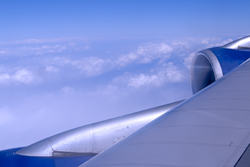Controlling air flow over wings during supersonic flight
Supersonic planes fly at speeds faster than the speed of sound, about 1 200 km/hr at sea level. Their flight generates so-called sonic booms. A shock wave is formed as the plane essentially pushes air molecules out of the way much like a boat creates a wave on its bow as it moves through the water. The thunder-like noise is heard on the ground after the wave passes and there is a sudden decrease in pressure as when a balloon is popped. Needless to say, the noise is intense and the pressure wave often rattles the windows of buildings in the local environment. One way to decrease the noise, pollution and fuel consumption generated by supersonic flight is to control the transition from laminar to turbulent air flow over the wings. Although laminar flow control techniques have been widely studied for subsonic and transonic flows, little is known about the feasibility of such methods related to supersonic flight. European researchers sought to evaluate this possibility with funding for the ‘Supersonic transition control’ (Supertrac) project. With nine partners including two aircraft manufacturers, the scientists employed numerical modelling techniques as well as wind tunnel experiments to develop transition control techniques and test them. Researchers focused on numerical techniques involving micron-sized roughness (MSR) elements, a new approach to reduce turbulent flow and thus friction drag, satisfying emission and noise specifications as well as reducing fuel consumption. The MSR experiments along with several other methods employed were the first of their kind in Europe related to supersonic flows. Together with detailed numerical analyses, they enabled careful evaluation and explanation of results pointing to important future research directions. In addition, Supertrac defined the optimal supersonic three-dimensional (3D) wing and its expected benefits in terms of drag and fuel consumption reduction. %Supertrac has successfully exploited cutting-edge numerical and experimental techniques leading to resolution of numerous open questions related to laminar flow around wings during supersonic flight.







